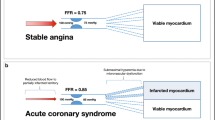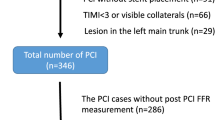Abstract
Fractional flow reserve (FFR) is a useful modality to assess the functional significance of coronary stenoses. Although adenosine triphosphate (ATP) is generally used as the hyperemic stimulus, we sometimes encounter adverse events like hypotension during FFR measurement. Nicorandil, an ATP-sensitive potassium channel opener, recognized as an epicardial and resistance vessel dilator, has not been fully evaluated as a possible alternative hyperemic agent. The aim of this study was to evaluate the feasibility and safety of intracoronary nicorandil infusion compared to intravenous ATP for FFR measurement in patients with coronary artery disease. A total of 102 patients with 124 intermediate lesions (diameter stenosis >40 and <70 % by visual assessment) were enrolled. All vessels underwent FFR measurements with both ATP (150 μg/kg/min) and nicorandil (2.0 mg) stimulus. FFR, hemodynamic values, and periprocedural adverse events between the two groups were evaluated. A strong correlation was observed between FFR with ATP and FFR with nicorandil (r = 0.954, p < 0.001). The agreement between the two sets of measurements was also high, with a mean difference of 0.01 ± 0.03. The mean aortic pressure drop during pharmacological stimulus was significantly larger with ATP compared to nicorandil (9.6 ± 9.6 vs. 5.5 ± 5.8 mmHg, p < 0.001). During FFR measurement, transient atrioventricular block was frequently observed with ATP compared to nicorandil (4.0 vs. 0 %, p = 0.024). This study suggests that intracoronary nicorandil infusion is associated with clinical utility and safety compared to ATP as an alternative hyperemic agent for FFR measurement.


Similar content being viewed by others
References
Pijls NH, van Schaardenburgh P, Manoharan G, Boersma E, Bech JW, van’t Veer M, Bar F, Hoorntje J, Koolen J, Wijns W, de Bruyne B (2007) Percutaneous coronary intervention of functionally nonsignificant stenosis: 5-year follow-up of the DEFER Study. J Am Coll Cardiol 49:2105–2111
Tonino PA, De Bruyne B, Pijls NH, Siebert U, Ikeno F, van’t Veer M, Klauss V, Manoharan G, Engstrom T, Oldroyd KG, Ver Lee PN, MacCarthy PA, Fearon WF (2009) Fractional flow reserve versus angiography for guiding percutaneous coronary intervention. N Engl J Med 360:213–224
Nam CW, Hur SH, Koo BK, Doh JH, Cho YK, Park HS, Yoon HJ, Kim H, Chung IS, Kim YN, Fearon WF, Tahk SJ, Kim KB (2011) Fractional flow reserve versus angiography in left circumflex ostial intervention after left main crossover stenting. Korean Circ J 41:304–307
Pijls NH (2013) Fractional flow reserve to guide coronary revascularization. Circ J 77:561–569
Pijls NH, van Son JA, Kirkeeide RL, De Bruyne B, Gould KL (1993) Experimental basis of determining maximum coronary, myocardial, and collateral blood flow by pressure measurements for assessing functional stenosis severity before and after percutaneous transluminal coronary angioplasty. Circulation 87:1354–1367
Pijls NH, Tonino PA (2011) The crux of maximum hyperemia: the last remaining barrier for routine use of fractional flow reserve. J Am Coll Cardiol Intv 4:1093–1095
Miyazawa A, Ikari Y, Tanabe K, Nakajima H, Aoki J, Iijima R, Nakayama T, Hatori M, Nakazawa G, Tanimoto S, Onuma Y, Hara K (2006) Intracoronary nicorandil prior to reperfusion in acute myocardial infarction. Euro Interv 2:211–217
Kobatake R, Sato T, Fujiwara Y, Sunami H, Yoshioka R, Ikeda T, Saito H, Ujihira T (2011) Comparison of the effects of nitroprusside versus nicorandil on the slow/no-reflow phenomenon during coronary interventions for acute myocardial infarction. Heart Vessels 26:379–384
Matsuo H, Watanabe S, Watanabe T, Warita S, Kojima T, Hirose T, Iwama M, Ono K, Takahashi H, Segawa T, Minatoguchi S, Fujiwara H (2007) Prevention of no-reflow/slow-flow phenomenon during rotational atherectomy––a prospective randomized study comparing intracoronary continuous infusion of verapamil and nicorandil. Am Heart J 154(994):e991–e996
Hattori H, Minami Y, Mizuno M, Yumino D, Hoshi H, Arashi H, Nuki T, Sashida Y, Higashitani M, Serizawa N, Yamada N, Yamaguchi J, Mori F, Shiga T, Hagiwara N (2013) Differences in hemodynamic responses between intravenous carperitide and nicorandil in patients with acute heart failure syndromes. Heart Vessels 28:345–351
Sakata K, Namura M, Takagi T, Tama N, Inoki I, Terai H, Horita Y, Ikeda M, Yamagishi M (2014) Repeated occurrence of slow flow phenomenon during and late after sirolimus-eluting stent implantation. Heart Vessels. doi:10.1007/s00380-014-0477-8
Pijls NH, De Bruyne B, Peels K, Van Der Voort PH, Bonnier HJ, Bartunek JKJJ, Koolen JJ (1996) Measurement of fractional flow reserve to assess the functional severity of coronary-artery stenoses. N Engl J Med 334:1703–1708
Jang HJ, Koo BK, Lee HS, Park JB, Kim JH, Seo MK, Yang HM, Park KW, Nam CW, Doh JH, Kim HS (2013) Safety and efficacy of a novel hyperaemic agent, intracoronary nicorandil, for invasive physiological assessments in the cardiac catheterization laboratory. Eur Heart J 34:2055–2062
Hongo M, Takenaka H, Uchikawa S, Nakatsuka T, Watanabe N, Sekiguchi M (1995) Coronary microvascular response to intracoronary administration of nicorandil. Am J Cardiol 75:246–250
Bland JM, Altman DG (1986) Statistical methods for assessing agreement between two methods of clinical measurement. Lancet 1:307–310
Ishii H, Ichimiya S, Kanashiro M, Amano T, Imai K, Murohara T, Matsubara T (2005) Impact of a single intravenous administration of nicorandil before reperfusion in patients with ST-segment-elevation myocardial infarction. Circulation 112:1284–1288
Asakura M, Kitakaze M (2010) Cardioprotection in the clinical setting-lessons from J-WIND studies. Cardiovasc Drugs Ther 24:289–295
IONA Study Group (2002) Effect of nicorandil on coronary events in patients with stable angina: the Impact Of Nicorandil in Angina (IONA) randomised trial. Lancet 359:1269–1275
Horinaka S, Yabe A, Yagi H, Ishimitsu T, Yamazaki T, Suzuki S, Kohro T, Nagai R (2010) Effects of nicorandil on cardiovascular events in patients with coronary artery disease in the Japanese Coronary Artery Disease (JCAD) study. Circ J 74:503–509
Nair PK, Marroquin OC, Mulukutla SR, Khandhar S, Gulati V, Schindler JT, Lee JS (2011) Clinical utility of regadenoson for assessing fractional flow reserve. J Am Coll Cardiol Intv 4:1085–1092
Arumugham P, Figueredo VM, Patel PB, Morris DL (2013) Comparison of intravenous adenosine and intravenous regadenoson for the measurement of pressure-derived coronary fractional flow reserve. Euro Interv 8:1166–1171
Rudzinski W, Waller AH, Rusovici A, Dehnee A, Nasur A, Benz M, Sanchez S, Klapholz M, Kaluski E (2013) Comparison of efficacy and safety of intracoronary sodium nitroprusside and intravenous adenosine for assessing fractional flow reserve. Catheter Cardiovasc Interv 81:540–544
Leone AM, Porto I, De Caterina AR, Basile E, Aurelio A, Gardi A, Russo D, Laezza D, Niccoli G, Burzotta F, Trani C, Mazzari MA, Mongiardo R, Rebuzzi AG, Crea F (2012) Maximal hyperemia in the assessment of fractional flow reserve: intracoronary adenosine versus intracoronary sodium nitroprusside versus intravenous adenosine: the NASCI (Nitroprussiato versus Adenosina nelle Stenosi Coronariche Intermedie) study. J Am Coll Cardiol Intv 5:402–408
Parham WA, Bouhasin A, Ciaramita JP, Khoukaz S, Herrmann SC, Kern MJ (2004) Coronary hyperemic dose responses of intracoronary sodium nitroprusside. Circulation 109:1236–1243
Acknowledgments
The authors thank Heidi N. Bonneau, RN, MS, CCA, for her review of this manuscript.
Author information
Authors and Affiliations
Corresponding author
Rights and permissions
About this article
Cite this article
Kato, D., Takashima, H., Waseda, K. et al. Feasibility and safety of intracoronary nicorandil infusion as a novel hyperemic agent for fractional flow reserve measurements. Heart Vessels 30, 477–483 (2015). https://doi.org/10.1007/s00380-014-0508-5
Received:
Accepted:
Published:
Issue Date:
DOI: https://doi.org/10.1007/s00380-014-0508-5




